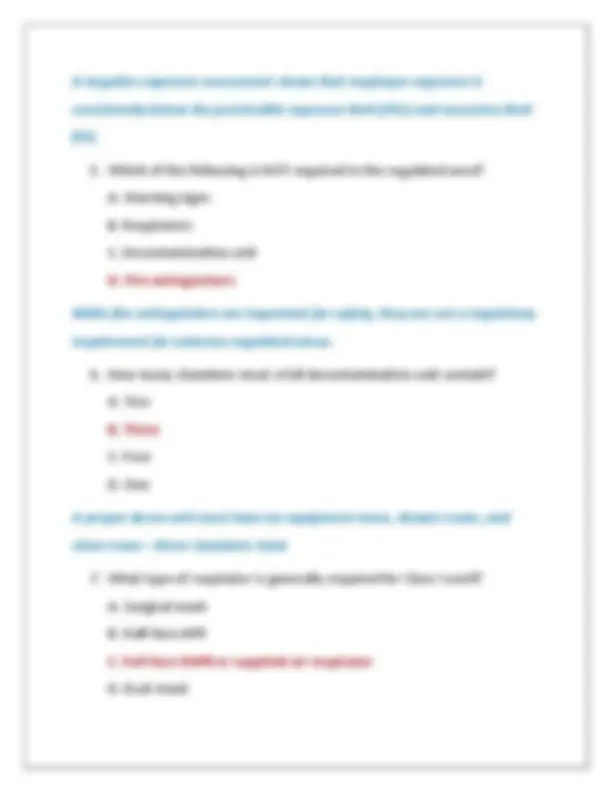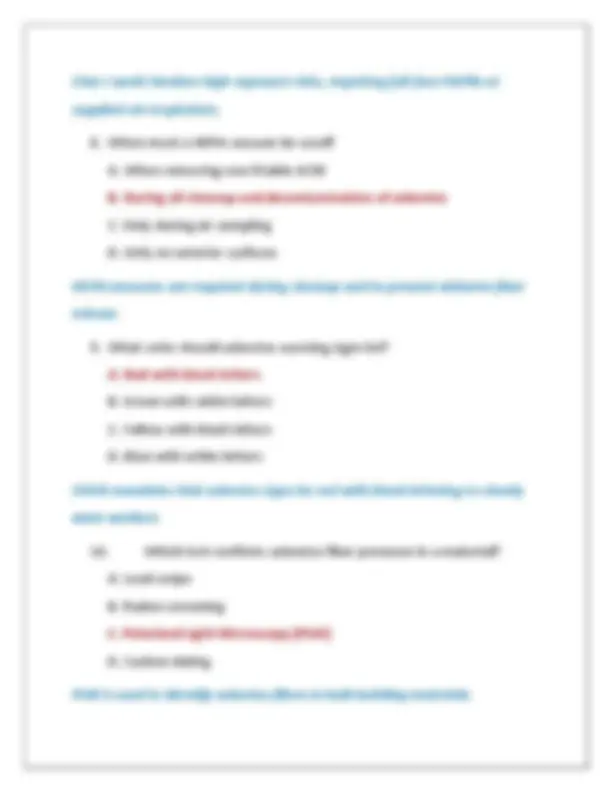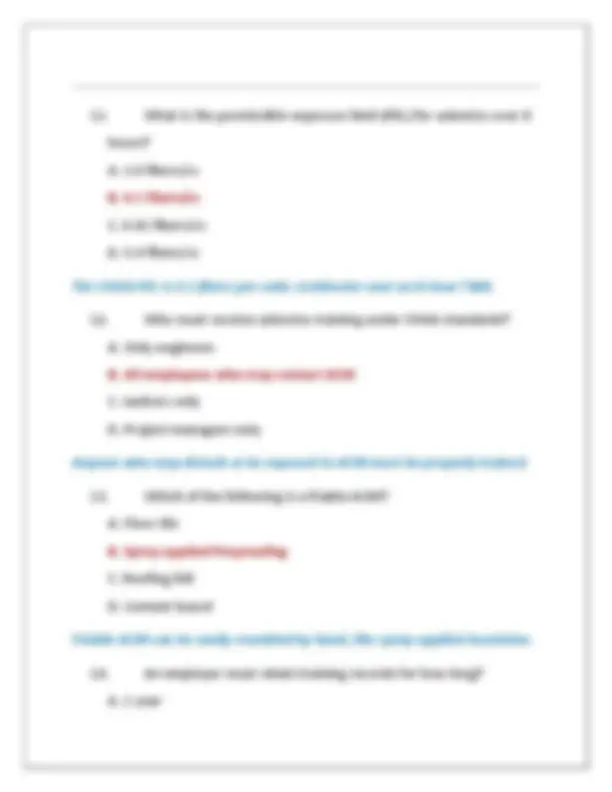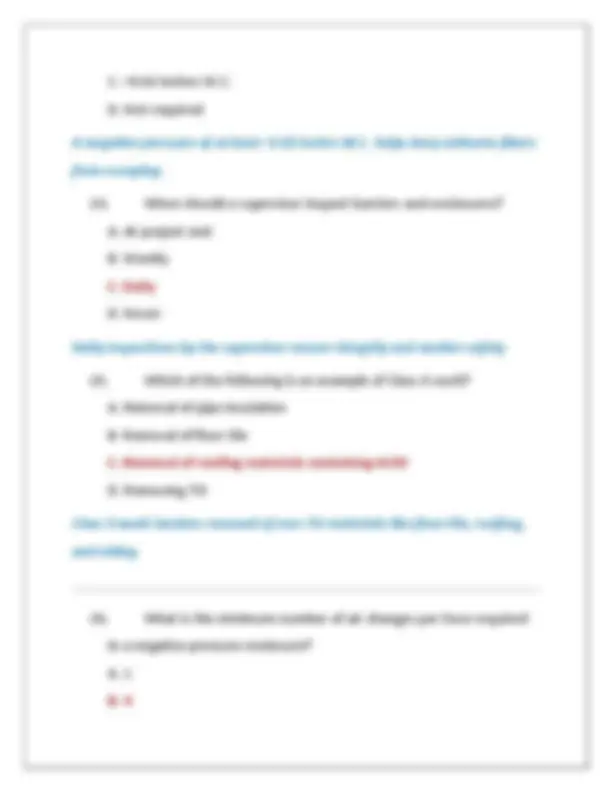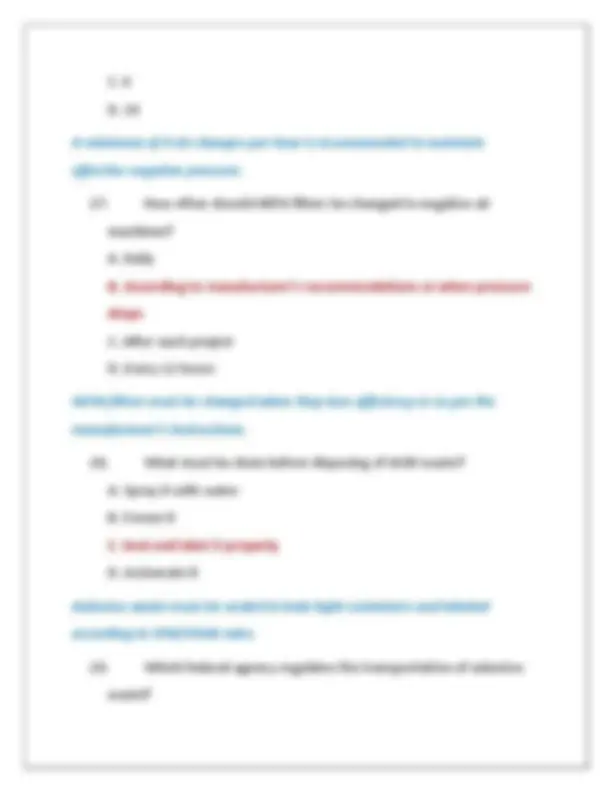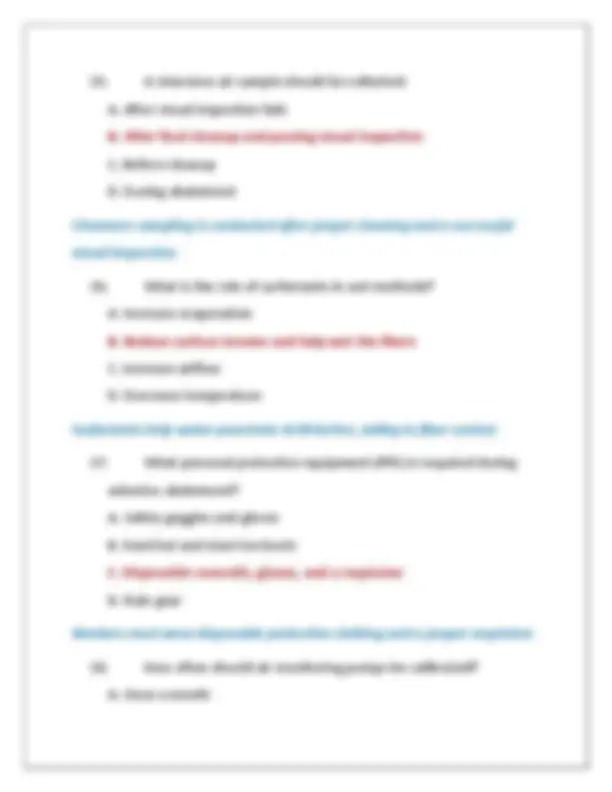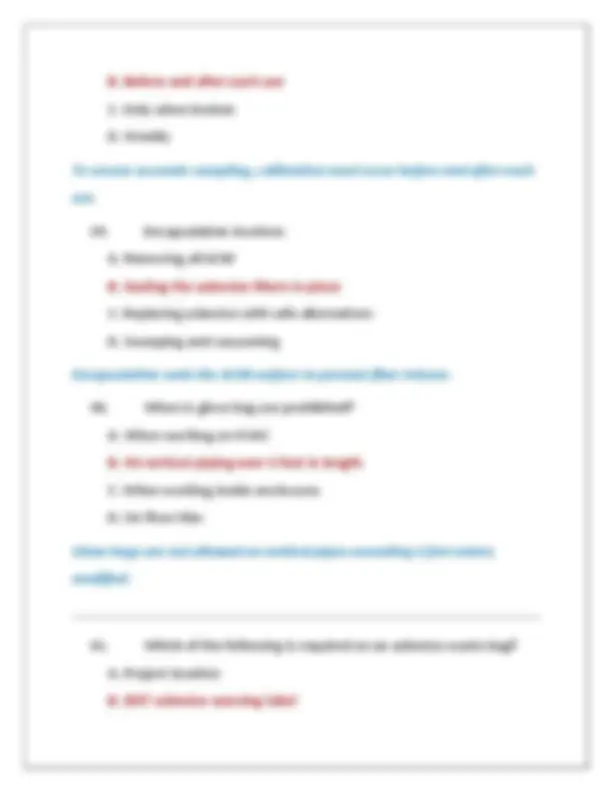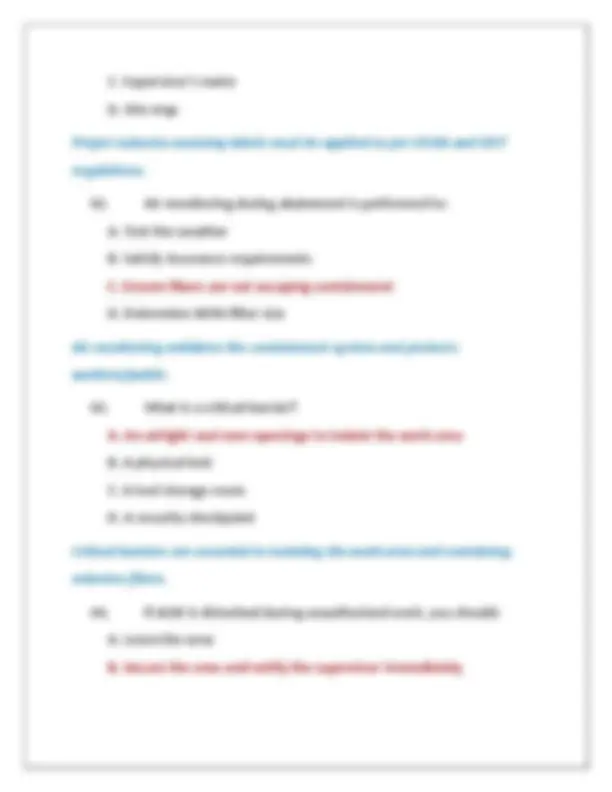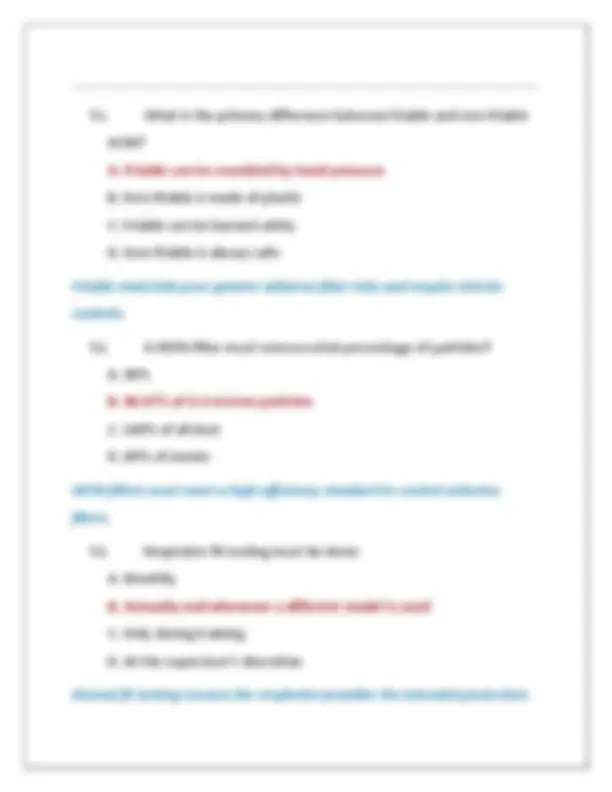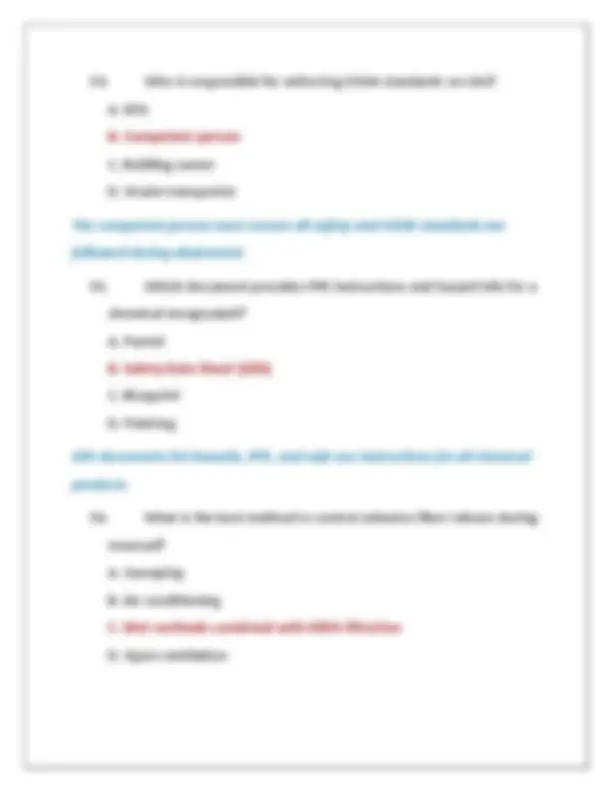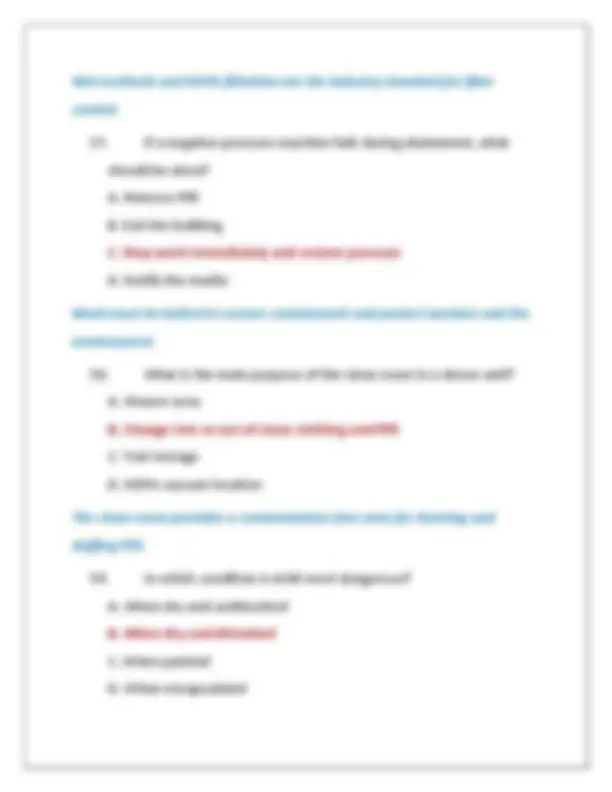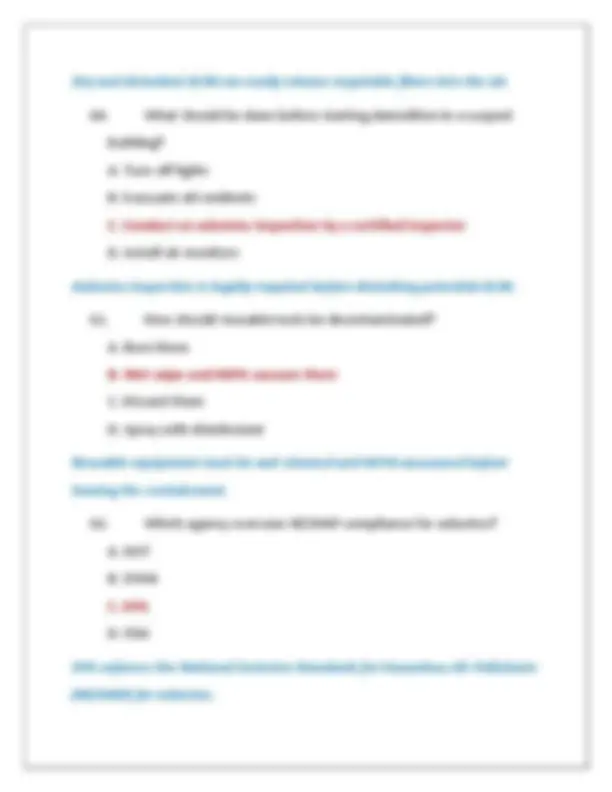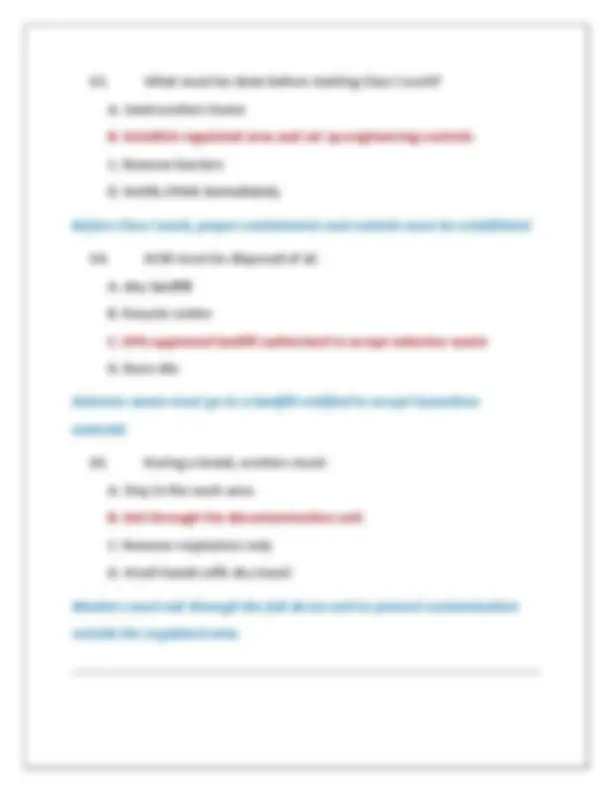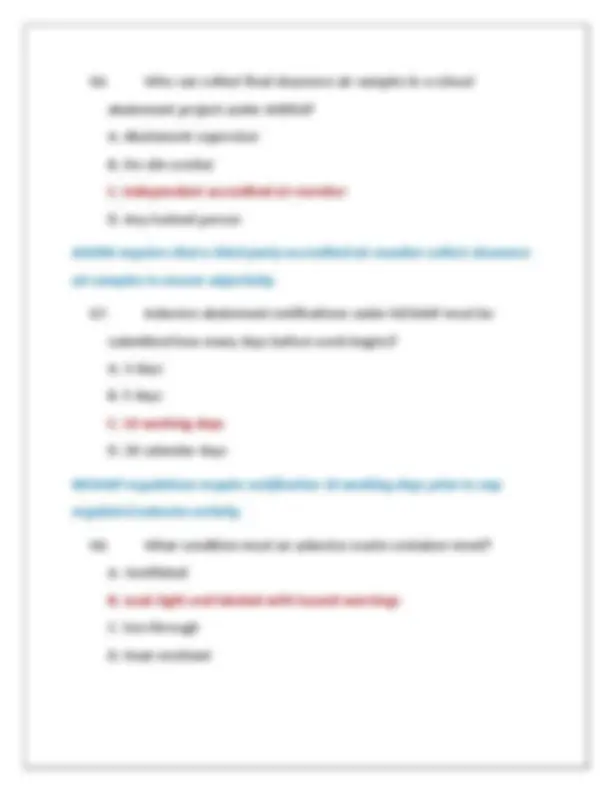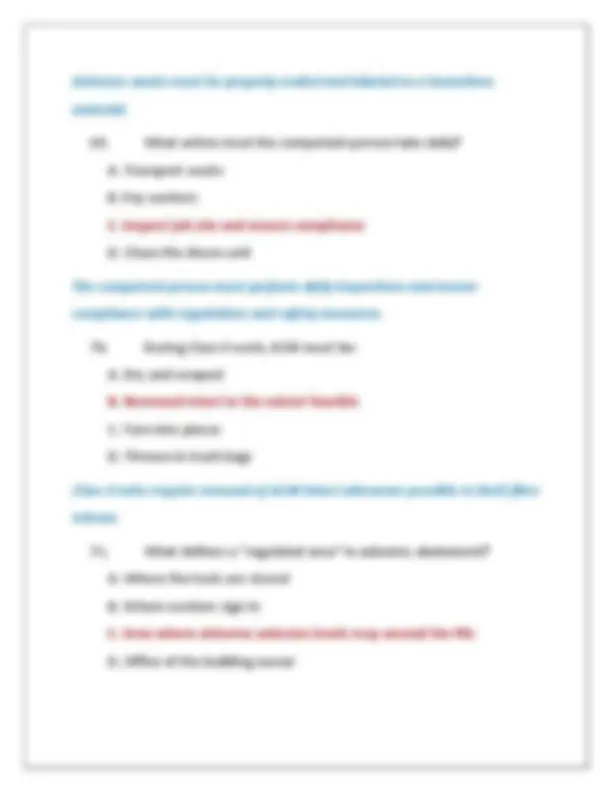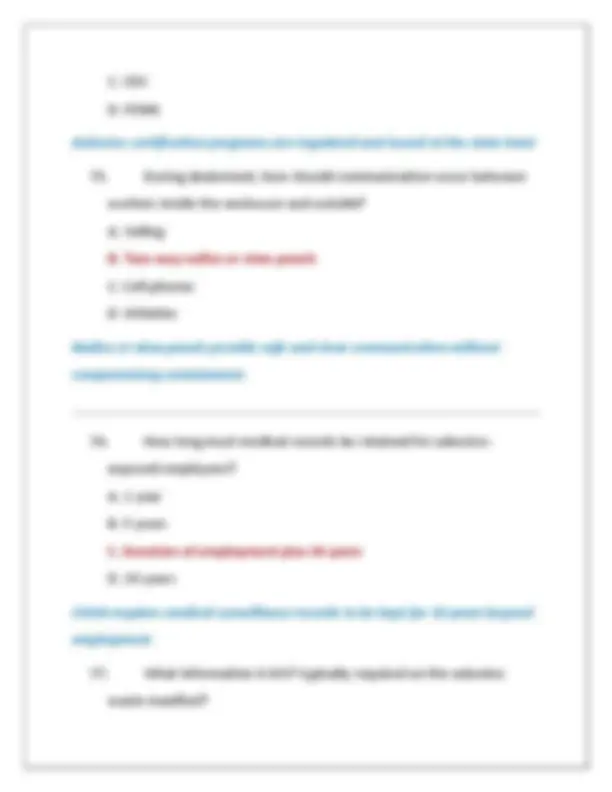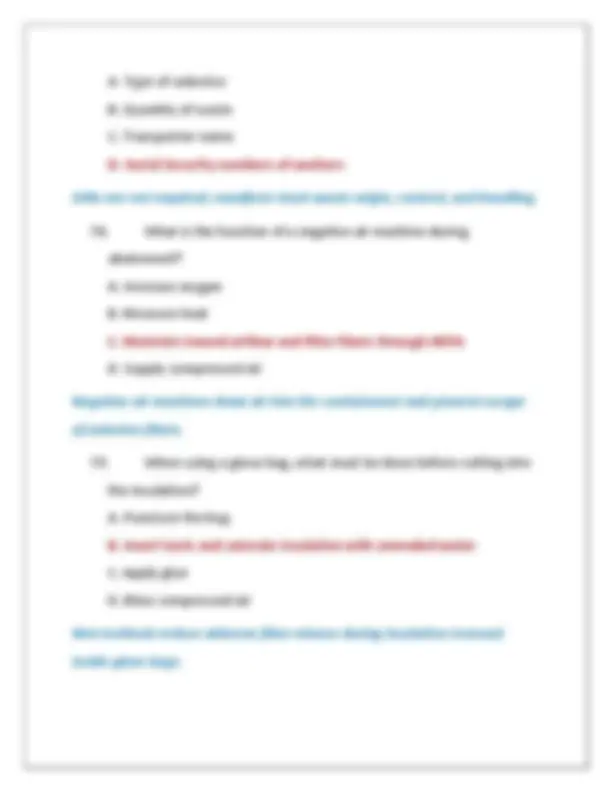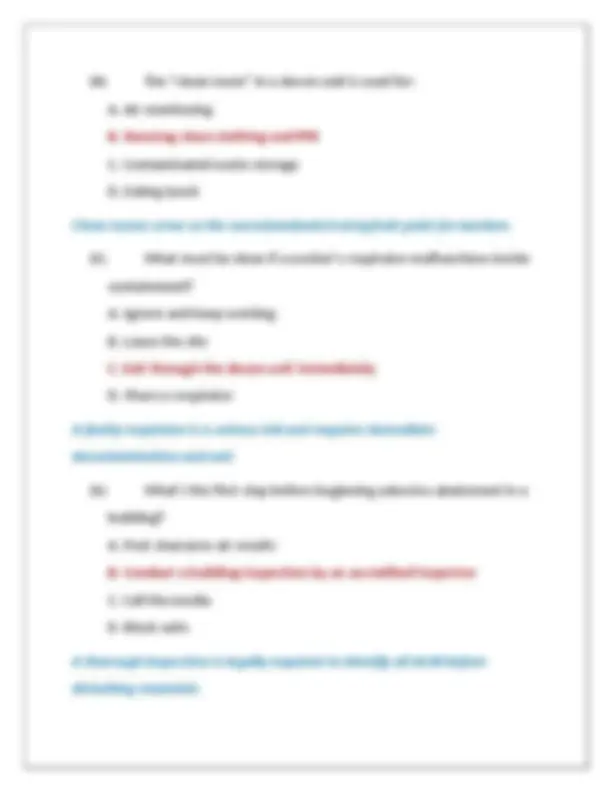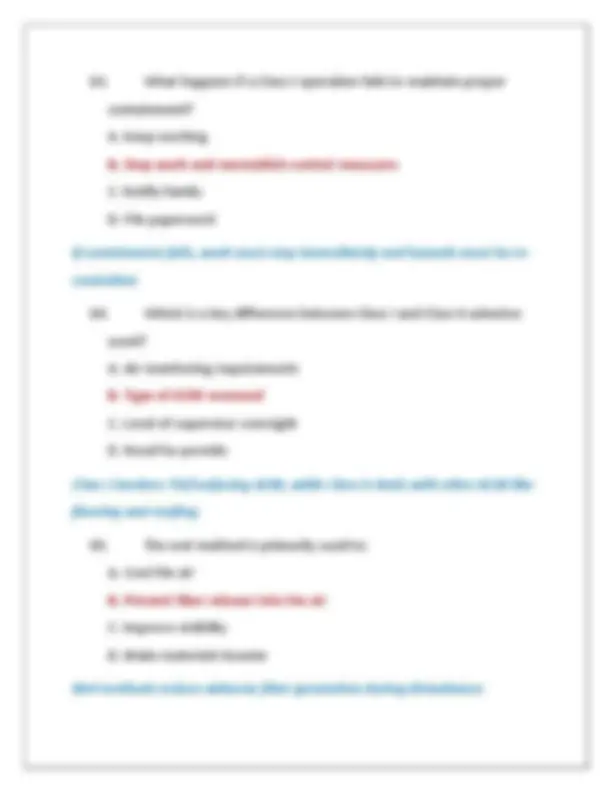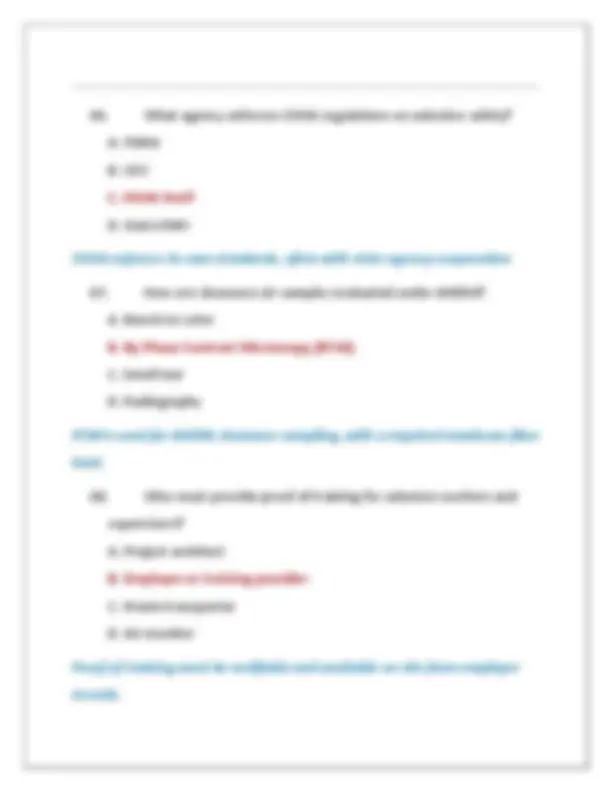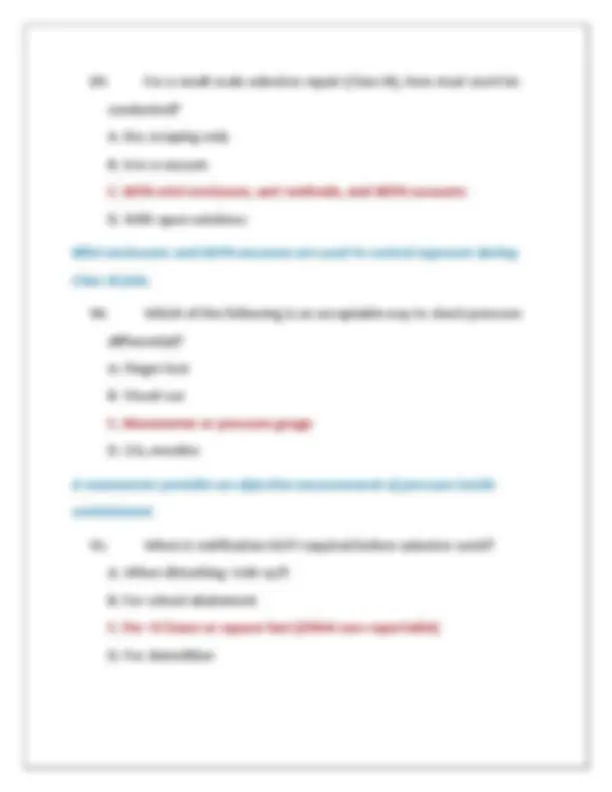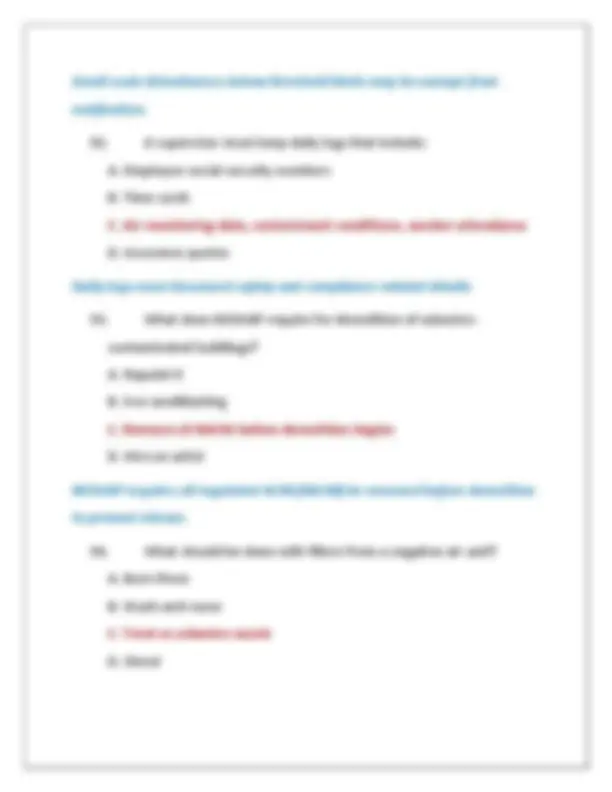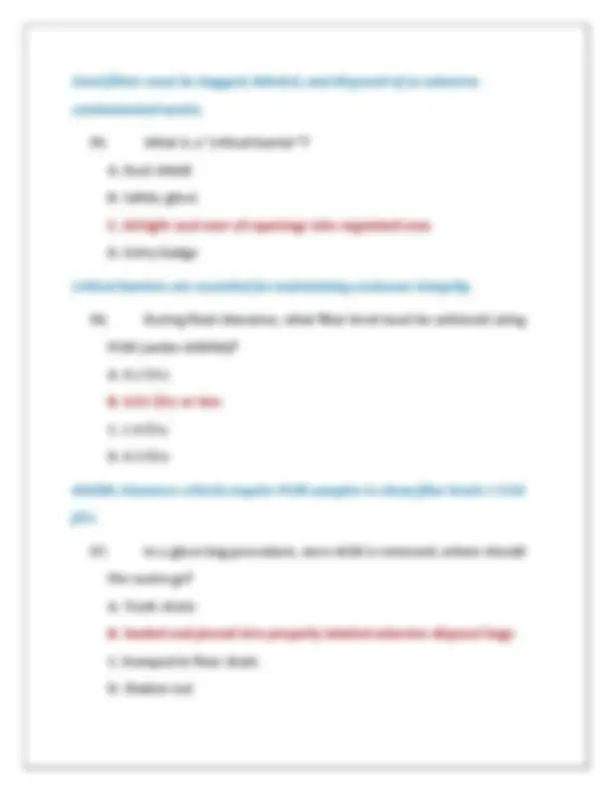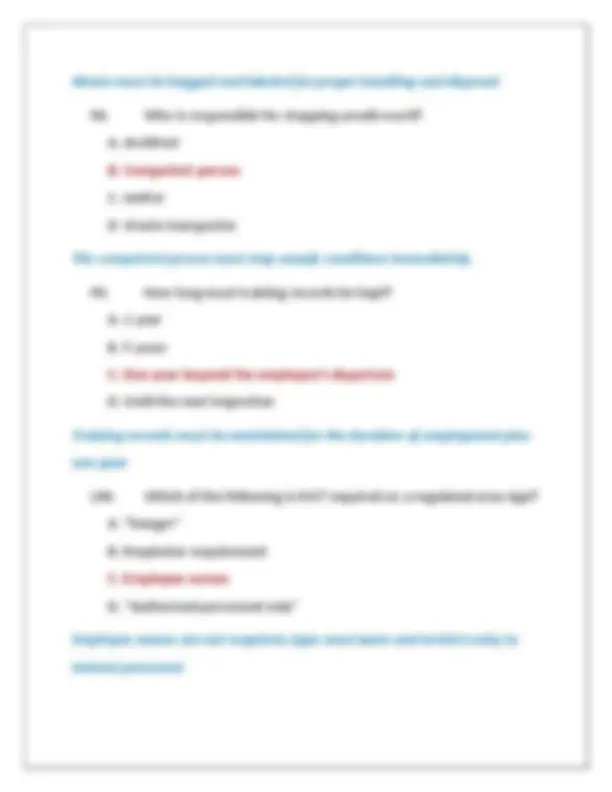Download ASBESTOS SUPERVISOR CERTIFICATION PRACTICE EXAM 1 QUESTIONS AND CORRECT ANSWERS (VERIFIE and more Exams Environmental Engineering in PDF only on Docsity!
ASBESTOS SUPERVISOR CERTIFICATION
PRACTICE EXAM 1 QUESTIONS AND
CORRECT ANSWERS (VERIFIED
ANSWERS) PLUS RATIONALES 2025
Q&A | INSTANT DOWNLOAD PDF
- What is the primary purpose of the OSHA Asbestos Standard for the construction industry? A. Protect property values B. Improve productivity C. Protect workers from asbestos exposure D. Reduce paperwork The OSHA standard (29 CFR 1926.1101) is designed to limit worker exposure to asbestos and ensure proper safety procedures are followed.
- Which class of asbestos work involves the removal of thermal system insulation and surfacing materials?
A. Class III B. Class I C. Class II D. Class IV Class I asbestos work includes activities involving the removal of TSI and surfacing ACM or PACM.
- A competent person must conduct exposure assessments for which class of asbestos work? A. Class IV only B. Class III and IV C. All classes of asbestos work D. Class II only All asbestos work requires oversight by a competent person, especially for exposure assessments and control measures.
- Negative exposure assessments must demonstrate employee exposure is: A. Below 0.1 fibers/cc over 30 minutes B. Below the PEL and EL for the full shift C. Below 1.0 fibers/cc for 15 minutes D. Eliminated by PPE
Class I work involves high exposure risks, requiring full-face PAPRs or supplied-air respirators.
- When must a HEPA vacuum be used? A. When removing non-friable ACM B. During all cleanup and decontamination of asbestos C. Only during air sampling D. Only on exterior surfaces HEPA vacuums are required during cleanup and to prevent airborne fiber release.
- What color should asbestos warning signs be? A. Red with black letters B. Green with white letters C. Yellow with black letters D. Blue with white letters OSHA mandates that asbestos signs be red with black lettering to clearly warn workers.
- Which test confirms asbestos fiber presence in a material? A. Lead swipe B. Radon screening C. Polarized Light Microscopy (PLM) D. Carbon dating PLM is used to identify asbestos fibers in bulk building materials.
- What is the permissible exposure limit (PEL) for asbestos over 8 hours? A. 1.0 fibers/cc B. 0.1 fibers/cc C. 0.01 fibers/cc D. 5.0 fibers/cc The OSHA PEL is 0.1 fibers per cubic centimeter over an 8-hour TWA.
- Who must receive asbestos training under OSHA standards? A. Only engineers B. All employees who may contact ACM C. Janitors only D. Project managers only Anyone who may disturb or be exposed to ACM must be properly trained.
- Which of the following is a friable ACM? A. Floor tile B. Spray-applied fireproofing C. Roofing felt D. Cement board Friable ACM can be easily crumbled by hand, like spray-applied insulation.
- An employer must retain training records for how long? A. 1 year
C. Safety officer D. Competent person The competent person ensures compliance and safety for asbestos operations.
- What is a glove bag used for? A. Small-scale TSI removal B. Dust suppression C. Personal protection D. Respirator storage Glove bags are used to safely remove asbestos insulation from pipes and elbows.
- Waste bags for asbestos must be: A. Green with white label B. Transparent and sealed C. Leak-tight and labeled with asbestos warnings D. Burned immediately OSHA and EPA require asbestos waste to be double-bagged and labeled clearly.
- A visual inspection ensures: A. Negative air pressure B. No residual asbestos debris remains
C. Filter integrity D. Worker identity Visual inspection is required before clearance air sampling to confirm proper cleanup.
- Which regulation sets asbestos work standards for schools? A. CERCLA B. TSCA Title I C. AHERA D. FIFRA AHERA (Asbestos Hazard Emergency Response Act) mandates inspections and management in schools.
- The initial exposure assessment must be completed: A. At project end B. Before work begins C. After first break D. During lunch Exposure assessments are done before asbestos work begins to evaluate risks.
- Negative pressure in a containment area should be: A. Equal to outside air B. - 0.02 inches of water column or more
C. 6
D. 10
A minimum of 4 air changes per hour is recommended to maintain effective negative pressure.
- How often should HEPA filters be changed in negative air machines? A. Daily B. According to manufacturer’s recommendations or when pressure drops C. After each project D. Every 12 hours HEPA filters must be changed when they lose efficiency or as per the manufacturer’s instructions.
- What must be done before disposing of ACM waste? A. Spray it with water B. Freeze it C. Seal and label it properly D. Incinerate it Asbestos waste must be sealed in leak-tight containers and labeled according to EPA/OSHA rules.
- Which federal agency regulates the transportation of asbestos waste?
A. OSHA
B. Department of Transportation (DOT) C. EPA D. NRC The DOT regulates the packaging, labeling, and transportation of hazardous waste including asbestos.
- When is medical surveillance required for workers? A. If they handle Class IV work B. Only after a complaint C. When employees are exposed at or above the PEL for 30+ days per year D. For Class II jobs only Medical surveillance is required for workers exposed above the PEL for a combined total of 30 or more days annually.
- A Class III asbestos job involves: A. Cleaning ACM off surfaces B. Repair and maintenance operations involving ACM C. Encapsulating asbestos D. Surveying a building Class III refers to repair and maintenance where ACM is likely to be disturbed.
- A clearance air sample should be collected: A. After visual inspection fails B. After final cleanup and passing visual inspection C. Before cleanup D. During abatement Clearance sampling is conducted after proper cleaning and a successful visual inspection.
- What is the role of surfactants in wet methods? A. Increase evaporation B. Reduce surface tension and help wet the fibers C. Increase airflow D. Decrease temperature Surfactants help water penetrate ACM better, aiding in fiber control.
- What personal protective equipment (PPE) is required during asbestos abatement? A. Safety goggles and gloves B. Hard hat and steel toe boots C. Disposable coveralls, gloves, and a respirator D. Rain gear Workers must wear disposable protective clothing and a proper respirator.
- How often should air monitoring pumps be calibrated? A. Once a month
B. Before and after each use C. Only when broken D. Weekly To ensure accurate sampling, calibration must occur before and after each use.
- Encapsulation involves: A. Removing all ACM B. Sealing the asbestos fibers in place C. Replacing asbestos with safe alternatives D. Sweeping and vacuuming Encapsulation seals the ACM surface to prevent fiber release.
- When is glove bag use prohibited? A. When working on HVAC B. On vertical piping over 3 feet in length C. When working inside enclosures D. On floor tiles Glove bags are not allowed on vertical pipes exceeding 3 feet unless modified.
- Which of the following is required on an asbestos waste bag? A. Project location B. DOT asbestos warning label
C. Continue working carefully D. Spray it with bleach The site must be secured and the competent person notified to evaluate the hazard.
- The main hazard of asbestos exposure is: A. Skin irritation B. Coughing C. Lung disease including mesothelioma D. Hair loss Inhalation of asbestos fibers can cause severe, often fatal, lung diseases.
- Before beginning asbestos abatement, the building owner must: A. Leave the site B. Notify EPA or local agency C. Issue a paycheck D. Shut off fire alarms Notification requirements exist at federal and state levels prior to abatement.
- What is the purpose of a shower in the decontamination unit? A. Wash tools B. Clean the enclosure C. Remove asbestos fibers from workers D. Refill respirators
Showers reduce the risk of fiber transfer from the containment area to clean zones.
- Which of the following is a responsibility of the asbestos supervisor? A. Skip safety meetings B. Issue fines C. Ensure workers follow safety protocols and procedures D. Conduct lab analysis The supervisor must enforce site safety and regulatory compliance.
- When can containment barriers be removed? A. After lunch B. Before visual inspection C. After passing clearance air monitoring D. Immediately after final waste removal Barriers remain in place until air sampling confirms the area is safe.
- What is the correct disposal method for asbestos-contaminated disposable suits? A. Rinse and reuse B. Shake out and store C. Bag and label as asbestos waste D. Donate to charity Contaminated PPE must be treated as regulated asbestos waste.
- Who is responsible for enforcing OSHA standards on-site? A. EPA B. Competent person C. Building owner D. Waste transporter The competent person must ensure all safety and OSHA standards are followed during abatement.
- Which document provides PPE instructions and hazard info for a chemical encapsulant? A. Permit B. Safety Data Sheet (SDS) C. Blueprint D. Field log SDS documents list hazards, PPE, and safe use instructions for all chemical products.
- What is the best method to control asbestos fiber release during removal? A. Sweeping B. Air conditioning C. Wet methods combined with HEPA filtration D. Open ventilation
Wet methods and HEPA filtration are the industry standard for fiber control.
- If a negative pressure machine fails during abatement, what should be done? A. Remove PPE B. Exit the building C. Stop work immediately and restore pressure D. Notify the media Work must be halted to restore containment and protect workers and the environment.
- What is the main purpose of the clean room in a decon unit? A. Shower area B. Change into or out of clean clothing and PPE C. Tool storage D. HEPA vacuum location The clean room provides a contamination-free area for donning and doffing PPE.
- In which condition is ACM most dangerous? A. When dry and undisturbed B. When dry and disturbed C. When painted D. When encapsulated

